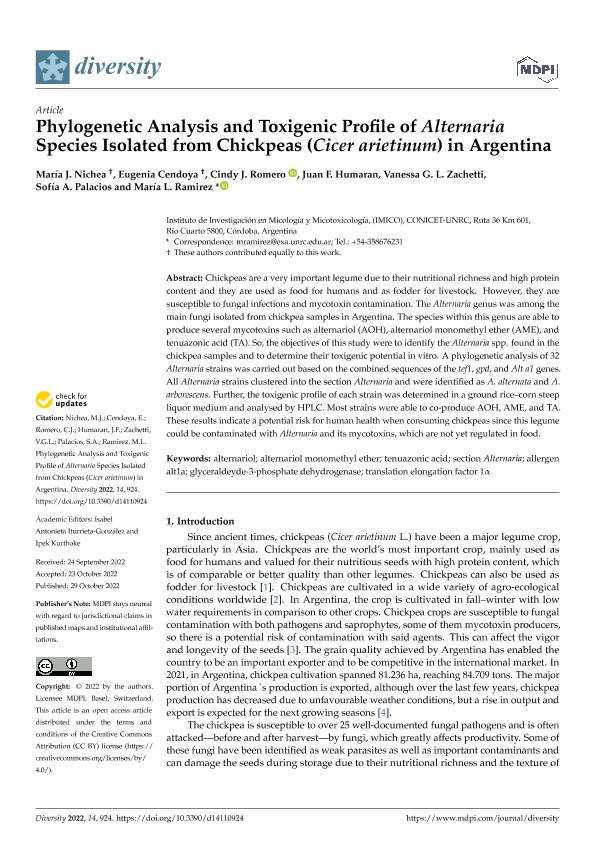Artículo
Phylogenetic analysis and toxigenic profile of Alternaria species isolated from chickpeas (Cicer arietinum) in Argentina
Nichea, Maria Julia ; Cendoya, Eugenia
; Cendoya, Eugenia ; Romero Donato, Cindy Johana
; Romero Donato, Cindy Johana ; Humaran, Juan Francisco; Zachetti, Vanessa Gimena Lourdes
; Humaran, Juan Francisco; Zachetti, Vanessa Gimena Lourdes ; Palacios, Sofia Alejendra
; Palacios, Sofia Alejendra ; Ramirez, Maria Laura
; Ramirez, Maria Laura
 ; Cendoya, Eugenia
; Cendoya, Eugenia ; Romero Donato, Cindy Johana
; Romero Donato, Cindy Johana ; Humaran, Juan Francisco; Zachetti, Vanessa Gimena Lourdes
; Humaran, Juan Francisco; Zachetti, Vanessa Gimena Lourdes ; Palacios, Sofia Alejendra
; Palacios, Sofia Alejendra ; Ramirez, Maria Laura
; Ramirez, Maria Laura
Fecha de publicación:
11/2022
Editorial:
Multidisciplinary Digital Publishing Institute
Revista:
Diversity
e-ISSN:
1424-2818
Idioma:
Inglés
Tipo de recurso:
Artículo publicado
Clasificación temática:
Resumen
Chickpeas are a very important legume due to their nutritional richness and high protein content and they are used as food for humans and as fodder for livestock. However, they are susceptible to fungal infections and mycotoxin contamination. The Alternaria genus was among the main fungi isolated from chickpea samples in Argentina. The species within this genus are able to produce several mycotoxins such as alternariol (AOH), alternariol monomethyl ether (AME), and tenuazonic acid (TA). So, the objectives of this study were to identify the Alternaria spp. found in the chickpea samples and to determine their toxigenic potential in vitro. A phylogenetic analysis of 32 Alternaria strains was carried out based on the combined sequences of the tef1, gpd, and Alt a1 genes. All Alternaria strains clustered into the section Alternaria and were identified as A. alternata and A. arborescens. Further, the toxigenic profile of each strain was determined in a ground rice–corn steep liquor medium and analysed by HPLC. Most strains were able to co-produce AOH, AME, and TA. These results indicate a potential risk for human health when consuming chickpeas since this legume could be contaminated with Alternaria and its mycotoxins, which are not yet regulated in food.
Archivos asociados
Licencia
Identificadores
Colecciones
Articulos (IMICO)
Articulos de INSTITUTO DE INVESTIGACION EN MICOLOGIA Y MICOTOXICOLOGIA
Articulos de INSTITUTO DE INVESTIGACION EN MICOLOGIA Y MICOTOXICOLOGIA
Citación
Nichea, Maria Julia; Cendoya, Eugenia; Romero Donato, Cindy Johana; Humaran, Juan Francisco; Zachetti, Vanessa Gimena Lourdes; et al.; Phylogenetic analysis and toxigenic profile of Alternaria species isolated from chickpeas (Cicer arietinum) in Argentina; Multidisciplinary Digital Publishing Institute; Diversity; 14; 924; 11-2022; 1-10
Compartir
Altmétricas



